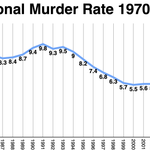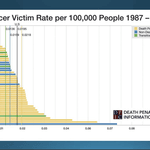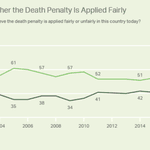Overview
The foundation for the death penalty in the U.S. rests on whether it is necessary as a response to murder. About 40 percent of the states have ended the use of capital punishment. Of the remaining states that retain it, only a few use it on a regular basis. The murder rates of states with and without the death penalty are relevant to whether it is justified. The murder rate for the country as a whole over various time periods is also a barometer of whether or not the public will be in favor of harsher punishments for crime. Murder rates, which are the result of dividing the number of murders by the population of a jurisdiction, can be more useful in comparing states and countries than the absolute number of murders committed.
At Issue
In trying to measure whether the use of the death penalty has an effect on the level of violent crime, researchers often use murder rates and compare them with the practice of the death penalty, either through the number of executions or death sentences. This is problematic on a national basis because the death penalty is not available in many states, and where it is carried out, the executions amount to only a tiny percentage of the murders committed. Even when comparing states, it is difficult to single out whether the relatively rare use of the death penalty is causing a change in crime or whether the change is attributable to other causes such as the rate of employment, the quality of education, or many other local variables.
What DPIC Offers
DPIC has collected statistics published by the FBI on the murder rates in each state for each year, each geographical region, and for the country as a whole. DPIC deepens the analysis by noting whether each state had the death penalty for the time period in question. Murder rates can easily be compared with other available data, such as the number of executions, death sentences, and the size of death row.

Data Sources:
- FBI Uniform Crime Report for 2019 (published Sept. 2020)
- FBI Uniform Crime Report for 2018 (published Sept. 2019)
- FBI Uniform Crime Report for 2017 (published Sept. 2018)
- FBI Uniform Crime Report for 2016 (published Sept. 2017)
- FBI Uniform Crime Report for 2015 (published Oct. 2016)
- FBI Uniform Crime Report for 2014 (published Oct. 2015)
- FBI Uniform Crime Report for 2013 (published Nov. 2014)
- FBI Uniform Crime Reports for earlier years: 2012, 2011, 2010, 2009, 2008
News & Developments
News
Jun 09, 2023
New AH Datalytics Data Shows Sharp Decline in Murder Rates in 2023
New data from AH Datalytics shows“sharp and broad decline” in murder rates for 2023. In a recent article published in The Atlantic, Jeff Asher (pictured), a crime analyst based in New Orleans and co-founder of AH Datalytics, writes that the decline in murder rates across the United States is“one of the largest annual percent changes in murder…
Read MoreNews
Nov 15, 2022
Polls: Death Penalty Support Remains Near 50-Year Low Despite Record-High Perception that Crime Has Increased
Two national polls have found that support for capital punishment in the United States remains near half-century lows despite record-high perception that local crime…
Read MoreNews
Feb 24, 2022
Despite Ineffectiveness as Public-Safety Tool, Anti-Abolition Lawmakers Push Bills to Reinstate Death Penalty for Killings of Police Officers
Despite the absence of evidence that the death penalty protects police or promotes public safety, lawmakers in several states that have abolished capital punishment have introduced bills to reinstate capital punishment for the murders of…
Read MoreNews
Oct 22, 2018
Gallup Poll — Fewer than Half of Americans, a New Low, Believe Death Penalty is Applied Fairly
Fewer than half of Americans now believe the death penalty is fairly applied in the United States, according to the 2018 annual Gallup crime poll of U.S. adults, conducted October 1 – 10. The 49% of Americans who said they believed the death penalty was“applied fairly” was the lowest Gallup has ever recorded since it first included the question in its crime poll in 2000. The percentage of U.S. adults who said they believe the death penalty is unfairly…
Read MoreNews
Sep 25, 2018
FBI Crime Report Shows Murder Rates Stable in 2017
The FBI Uniform Crime Report for 2017, released by the U.S. Department of Justice, reports that murder rates stabilized across the United States in 2017, decreasing marginally compared to adjusted homicide figures from 2016 but remaining above the record lows recorded earlier in the decade. The initial FBI crime figures for 2017 report 17,284 murders across the United States in 2017, compared to 17,413 in 2016, dropping the nationwide murder…
Read More



